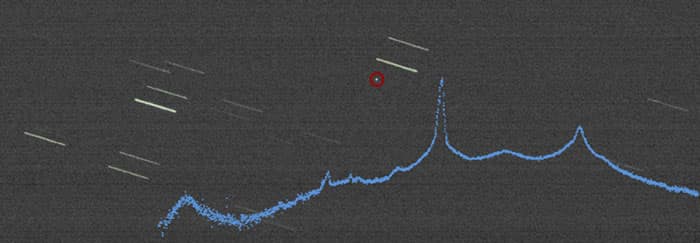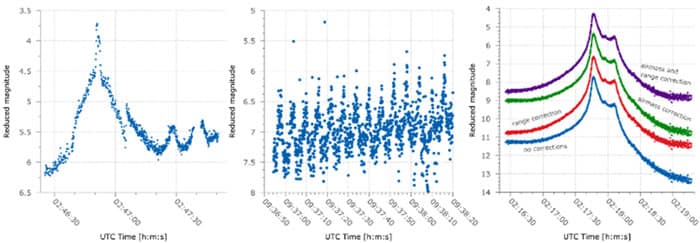
Precision photometry of low Earth orbit (LEO) objects is difficult because of the high angular rate of these objects as they pass over the observatory site. Tracking constraints are tight and require accurate timekeeping and mechanical considerations of the telescope mount. With the absence of conventional comparison stars and the large change in airmass over the satellite’s track, standard astronomical photometry requires careful calibration for accurate results.
The video below is an example of OSCOM assets tracking small satellites (in this case: NRL’s SpinSat using an 11″ Celestron Rowe-Ackermann Schmidt Astrograph). Note the static star field for the first 10 seconds. As SpinSat comes into the field of view, the telescope starts tracking the satellite. The stars appear as streaks, whereas the satellite is a simple dot that slowly moves up/down and left/right as the telescope controls are tested. For more videos, please visit our YouTube channel.
The OSCOM system has recorded hundreds of gigabytes of raw photometric images of nearly every kind of satellite in LEO. The image below, for example, showcases the light curves of three different satellites. The left and center curves demonstrate the photometry of large defense meteorology satellites, one stabilized and one tumbling. The rightmost light curve shows the effect of correcting for satellite range and airmass of the OPAL microsatellite.


SAIL students have created a custom photometry analysis toolset in Python that allows rapid reduction and analysis of images for photometry. Research is being conducted in robust techniques to extract accurate absolute photometry without time-consuming imaging of standard calibration star fields. As OSCOM’s light curve library grows, heuristic analysis techniques will be utilized to learn about the optical signature of different resident space objects and help identify unknown or uncontrolled objects.
As another example of tracking of objects in LEO, the video below captures the POPACS-2 satellite using the 11″ Celestron RASA telescope. The Polar Orbiting Passive Calibration Spheres (POPACS) mission launched three 10 cm passive spheres specifically for ground-based observations. These spheres allow observatories to verify the capability to detect a CubeSat-sized object. Photometry output for POPACS is shown in the image to the right. The trend is a straight line, as would be expected of a passive sphere. However, there is a significant spread in the photometry output, presumably due to low signal-to-noise ratio. SAIL has plans to acquire a 14″ RASA in the near future, which should lead to a better SNR.
